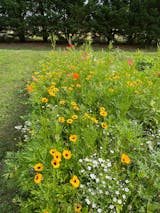Southeast Wildflower Mix
- Southeast Wildflower Mix - Contains 18 wildflower varieties (10 annuals, 8 perennials).
- Grows well in the Southeastern portion of the United States.
- Includes annuals that bloom in the first year and reseed.
- Includes perennials that bloom in the second year and continually bloom for years to come.
- Easy to grow and relatively maintenance-free.
- Grows well in NC, SC, TN, AR, TX, LA, MS, AL, GA and FL.
- Seeding rate: 1 lb per 1,000 sq. ft.
Description
Our Southeast Wildflower Mix contains a specialized blend designed to perform well in warmer, more humid climates. This mix includes a wide variety of flower colors and bloom types. Plant in early spring to ensure flowers can establish before extremely warm temperatures arrive in the summer months.
Southeast Wildflower Mix Benefits:
- Great for native bees and honeybees
- Provides excellent habitat for birds and butterflies
- Relatively low maintenance once established
- Blooms may be harvested for cut flowers
- Continuous blooms throughout the warm growing season
- Easily reSeeds and regrows year after year
Southeast Wildflower Mix Planting/Growing Instructions:
When to Plant
Wildflower seed mixes should be planted in spring after the risk of frost has passed. Seeds will germinate best once soil temps are above 60 degrees. In cooler climates, wildflower mixes may be planted late spring into early summer. In warmer climates, wildflower mixes should be planted in early spring to ensure plants become well-established before extreme heat arrives in the summer months.
How to Plant
Plant wildflowers in an area that receives at least 6 hours of full sun per day. Well-drained soils will perform best and wildflowers should not be planted in areas that tend to hold water after periods of heavy rainfall. Wildflowers should be planted in a tilled or cultivated area to reduce competition with weeds when plants are small.
We suggest preparing the plot several weeks in advance of the intended planting time. Cultivate or till the area every couple weeks to create a relatively weed-free planting zone. If a tiller or mechanical means of cultivation is not available, our Silage Tarps are a great way to kill grass and weeds in the intended planting area.
The average seeding rate for wildflower mixes is 1 lb per 1,000 sq. ft. This means that one would need 1/4 lb for 250 sq. ft. and 1/2 lb for a 500 sq. ft. area. Wildflower Seeds should be scattered evenly along the planting area, but do not need to be covered with soil for adequate germination. We do recommend rolling or packing the area after seeding to improve seed to soil contact for germination. Once planted, the area should be watered frequently to maintain soil moisture until plants are 4-6" tall.
Plot Maintenance
Wildflower plots may be mowed in fall or spring to increase future reseeding in the area. Once mowed, use a rake to comb through the area. This will help remove excess plant debris and "scuff" the ground to increase the reseeding potential of the plot.
Southeast Wildflower Mix Includes:
- 14.92% Baby's Breath (Gypsophila elegans) - annual
- 14.90% Scarlet Flax (Linum grandiflorum rubrum) - annual
- 13.03% Purple Coneflower (Echinacea purpurea) - perennial
- 11.17% Lance Leaved Coreopsis (Coreopsis lanceolata) - perennial
- 7.45% Bright Lights Sulphur Cosmos (Cosmos sulphureus) - annual
- 7.45% Tree Mallow (Lavatera trimestris) - annual
- 5.59% Annual Red Phlox (Phlox drummondii) - annual
- 3.72% Gaura (Gaura lindheimeri) - perennial
- 3.72% Indian Blanket (Gaillardia pulchella) - annual
- 1.86% Golden Wave Tickseed (Coreopsis basalis) - annual
- 1.86% Gilia (Ipomopsis rubra) - perennial
- 1.86% Purple Moss Verbena (Verbena tenuisecta) - perennial
- 1.23% Lemon Mint (Monarda citriodora) - annual
- 1.23% Clasping Coneflower (Rudbeckia amplexicaulis) - annual
- 0.90% Leavenworth's Tickseed (Coreopsis leavenworthii) - perennial
- 0.63% Plains Coreopsis (Coreopsis tinctoria) - annual
- 0.56% Black-Eyed Susan (Rudbeckia hirta) - perennial
- 0.48% New England Aster (Aster novae-angliae) - perennial





